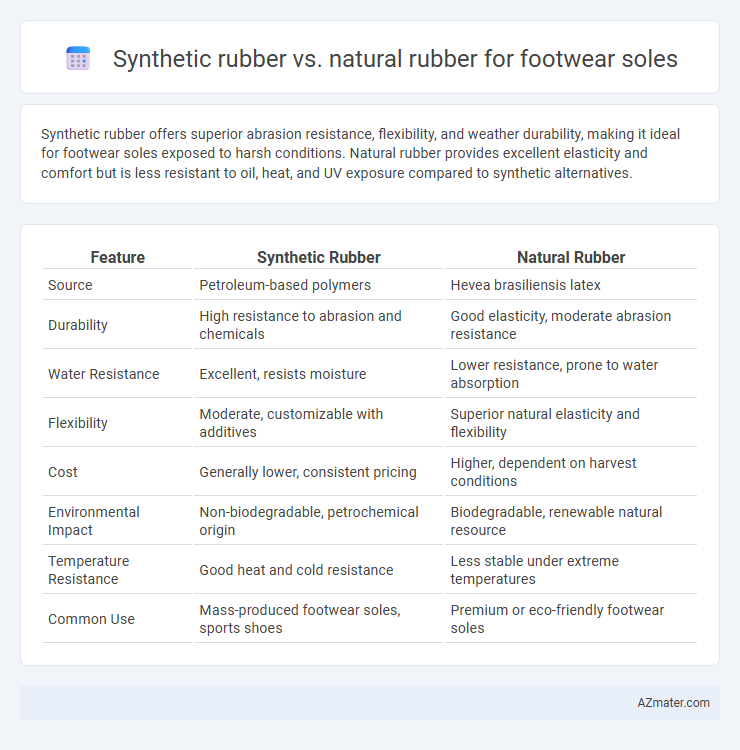Synthetic rubber offers superior abrasion resistance, flexibility, and weather durability, making it ideal for footwear soles exposed to harsh conditions. Natural rubber provides excellent elasticity and comfort but is less resistant to oil, heat, and UV exposure compared to synthetic alternatives.
Table of Comparison
| Feature | Synthetic Rubber | Natural Rubber |
|---|---|---|
| Source | Petroleum-based polymers | Hevea brasiliensis latex |
| Durability | High resistance to abrasion and chemicals | Good elasticity, moderate abrasion resistance |
| Water Resistance | Excellent, resists moisture | Lower resistance, prone to water absorption |
| Flexibility | Moderate, customizable with additives | Superior natural elasticity and flexibility |
| Cost | Generally lower, consistent pricing | Higher, dependent on harvest conditions |
| Environmental Impact | Non-biodegradable, petrochemical origin | Biodegradable, renewable natural resource |
| Temperature Resistance | Good heat and cold resistance | Less stable under extreme temperatures |
| Common Use | Mass-produced footwear soles, sports shoes | Premium or eco-friendly footwear soles |
Introduction to Rubber Materials in Footwear
Synthetic rubber offers enhanced durability, abrasion resistance, and consistent quality for footwear soles, making it ideal for high-performance and industrial applications. Natural rubber provides excellent elasticity, flexibility, and eco-friendly attributes, favored in comfort-oriented and eco-conscious footwear designs. Both materials play crucial roles in footwear manufacturing, selected based on performance requirements, cost-effectiveness, and environmental impact.
What is Natural Rubber?
Natural rubber, derived from the latex of rubber trees (Hevea brasiliensis), offers excellent elasticity, resilience, and biodegradability for footwear soles. Its molecular structure provides superior tensile strength and abrasion resistance, making it an ideal material for durable and comfortable shoe soles. Compared to synthetic rubber, natural rubber excels in flexibility and environmental sustainability but may be less resistant to oil and chemical exposure.
What is Synthetic Rubber?
Synthetic rubber, a man-made elastomer derived primarily from petroleum byproducts, offers consistent properties suited for footwear soles, including enhanced abrasion resistance, oil resistance, and durability compared to natural rubber. Common types such as styrene-butadiene rubber (SBR) and ethylene propylene diene monomer (EPDM) provide tailored performance for various footwear applications where flexibility and resilience are crucial. Its controlled manufacturing process allows for uniformity in tensile strength and elasticity, making synthetic rubber a preferred material in producing durable and long-lasting shoe soles.
Key Differences: Synthetic vs Natural Rubber
Synthetic rubber, made from petrochemical sources like styrene-butadiene, offers superior abrasion resistance and consistent quality essential for durable footwear soles, while natural rubber, derived from latex trees, provides excellent elasticity and better grip. The chemical composition of synthetic rubber leads to enhanced resistance against heat, oils, and aging, making it suitable for heavy-duty applications, whereas natural rubber soles excel in flexibility and biodegradability. Cost-effectiveness and production scalability favor synthetic rubber, whereas natural rubber remains preferred for eco-friendly and high-performance comfort footwear.
Durability and Wear Resistance
Synthetic rubber outperforms natural rubber in durability and wear resistance for footwear soles due to its engineered polymer composition that resists abrasion, chemicals, and temperature variations. Natural rubber offers excellent elasticity and comfort but degrades faster under harsh conditions, leading to quicker wear and reduced lifespan. High-performance footwear soles often incorporate synthetic rubber blends like styrene-butadiene rubber (SBR) to enhance toughness and extend product longevity.
Comfort and Flexibility Comparison
Synthetic rubber offers superior flexibility and consistent cushioning in footwear soles, enhancing comfort during prolonged wear by maintaining resilience under various temperatures. Natural rubber provides excellent elasticity and shock absorption, contributing to a soft, comfortable step but may lose flexibility in extreme cold or heat. Both materials impact foot comfort, with synthetic rubber excelling in durability and uniform performance, while natural rubber delivers a more natural, cushioned feel adaptable to foot movements.
Environmental Impact: Sustainability Concerns
Synthetic rubber for footwear soles is derived from petrochemicals, resulting in higher carbon emissions and non-biodegradability, which contribute to long-term environmental pollution. Natural rubber, harvested from rubber trees, offers better biodegradability and lower carbon footprint but involves issues like deforestation and land use change that impact ecosystems. Sustainable solutions include using recycled synthetic rubber and sourcing certified natural rubber to reduce environmental degradation in footwear production.
Cost Effectiveness and Availability
Synthetic rubber offers greater cost effectiveness for footwear soles due to lower production expenses and scalability, making it a preferred choice for mass manufacturing. Natural rubber, sourced from rubber trees, often incurs higher costs because of fluctuating harvest yields and limited geographic availability. The consistent supply and price stability of synthetic rubber provide manufacturers with reliable materials, while natural rubber remains valued for its elasticity and eco-friendliness in premium footwear applications.
Performance in Various Weather Conditions
Synthetic rubber offers superior resistance to abrasion, water, and extreme temperatures, making it ideal for footwear soles used in wet, cold, or hot climates. Natural rubber provides excellent elasticity and grip, especially in dry conditions, but tends to degrade faster under prolonged exposure to UV rays and moisture. Footwear soles combining both types can balance durability and comfort across diverse weather environments.
Choosing the Best Rubber Sole for Footwear
Synthetic rubber offers superior abrasion resistance and excellent flexibility ideal for high-performance footwear soles, while natural rubber provides better elasticity and eco-friendliness favored in casual or outdoor footwear. Choosing the best rubber sole depends on factors such as durability requirements, weather resistance, and environmental impact considerations. Footwear designed for intense physical activity often benefits from synthetic rubber's enhanced traction and wear resistance, whereas natural rubber supports sustainable production and comfort in everyday wear.

Infographic: Synthetic rubber vs Natural rubber for Footwear sole
 azmater.com
azmater.com